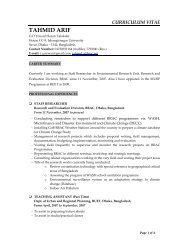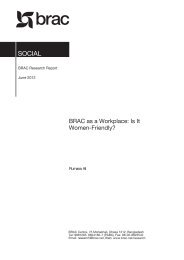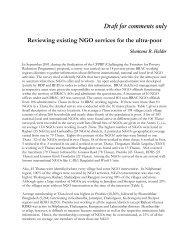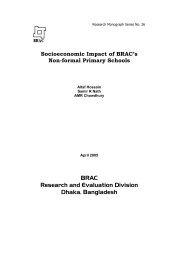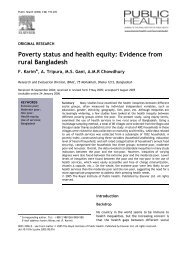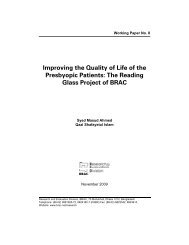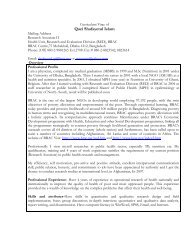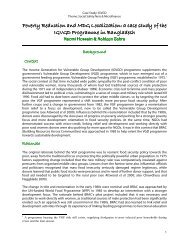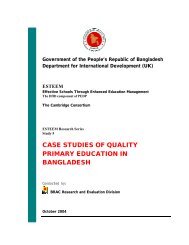Combining health and social protection measures to reach the ultra ...
Combining health and social protection measures to reach the ultra ...
Combining health and social protection measures to reach the ultra ...
Create successful ePaper yourself
Turn your PDF publications into a flip-book with our unique Google optimized e-Paper software.
Access <strong>to</strong> <strong>health</strong><br />
socio-cultural <strong>and</strong> ecological interactions,<br />
resulting in transborder processes <strong>and</strong><br />
effects” 2 . In order <strong>to</strong> focus <strong>the</strong> conceptual<br />
framework, however, <strong>the</strong> following important<br />
features of globalization are identified:<br />
✜ global governance structures;<br />
✜ global markets;<br />
✜ global mobility;<br />
✜ cross-cultural interaction;<br />
✜ global environmental changes.<br />
Based on Figure 1 <strong>and</strong> Table 1, it can be<br />
concluded that <strong>the</strong>se features all operate at<br />
<strong>the</strong> contextual level of <strong>health</strong> determination,<br />
influencing <strong>the</strong> distal <strong>health</strong> determinants. In<br />
turn, <strong>the</strong> changes in distal fac<strong>to</strong>rs have <strong>the</strong><br />
potential <strong>to</strong> affect <strong>the</strong> proximal determinants<br />
<strong>and</strong>, consequently, <strong>health</strong>. Figure 2 links <strong>the</strong><br />
above-mentioned features of <strong>the</strong> globalization<br />
process with <strong>the</strong> identified <strong>health</strong><br />
determinants 2 .<br />
Globalization <strong>and</strong> distal <strong>health</strong><br />
determinants<br />
Figure 2 shows that <strong>the</strong> processes of<br />
globalization can have an impact on <strong>the</strong><br />
identified distal <strong>health</strong> determinants. Below,<br />
<strong>the</strong> implications of <strong>the</strong> globalization process<br />
on <strong>the</strong>se distal determinants will be<br />
discussed in more detail.<br />
Health (-related) policies<br />
Global governance structures are<br />
increasingly gaining importance in<br />
formulating <strong>health</strong> (-related) policies.<br />
Important institutions in global <strong>health</strong><br />
governance include <strong>the</strong> World Health<br />
Organization (WHO) <strong>and</strong> <strong>the</strong> World Bank<br />
(WB) 8 . The latter plays an important role in<br />
<strong>the</strong> field of global <strong>health</strong> governance, as it<br />
acknowledges <strong>the</strong> importance of good <strong>health</strong><br />
for economic development <strong>and</strong> focuses on<br />
<strong>reach</strong>ing <strong>the</strong> Millennium Development<br />
Goals. The WB also influenced <strong>health</strong><br />
(-related) policies <strong>to</strong>ge<strong>the</strong>r with <strong>the</strong><br />
International Monetary Funds through <strong>the</strong><br />
Structural Adjustment Programmes 9 <strong>and</strong> <strong>the</strong><br />
Poverty Reduction Strategy 10 . In addition, <strong>the</strong><br />
policies of <strong>the</strong> World Trade Organization<br />
(WTO) are also increasingly influencing<br />
population <strong>health</strong> 9,11,12 . Fidler 13 argues that<br />
“from <strong>the</strong> international legal perspective, <strong>the</strong><br />
centre of power for global <strong>health</strong> governance<br />
has shifted from WHO <strong>to</strong> WTO”. Opinions<br />
differ with regard <strong>to</strong> whe<strong>the</strong>r WTO<br />
agreements provide sufficient possibilities <strong>to</strong><br />
protect <strong>the</strong> population from <strong>the</strong> adverse<br />
(<strong>health</strong>) effects of free trade or not 14 . In<br />
Level/ Nature General determinants More detailed determinants<br />
Contextual level<br />
Institutional Institutional infrastructure Governance structure<br />
Political environment<br />
System of law<br />
Regulation<br />
Economic Economic infrastructure Occupational structure<br />
Tax system<br />
Markets<br />
Socio-cultural Culture Religion<br />
Ideology<br />
Cus<strong>to</strong>ms<br />
Population<br />
Population size<br />
Structure<br />
Social infrastructure<br />
Environmental Ecological settings Ecosystems<br />
Climate<br />
Distal level<br />
Geographical distribution<br />
Social organization<br />
Knowledge development<br />
Social security<br />
Insurance system<br />
Mobility <strong>and</strong> communication<br />
Institutional Health policy Effective public <strong>health</strong> policy<br />
Sufficient public <strong>health</strong> budget<br />
Health-related policies<br />
Effective food policy<br />
Effective water policy<br />
Effective <strong>social</strong> policy<br />
Effective environmental policy<br />
Economic Economic development Income/wealth<br />
Economic equity<br />
Trade<br />
Trade in goods <strong>and</strong> services<br />
Marketing<br />
Socio-cultural Knowledge Education <strong>and</strong> literacy<br />
Health education<br />
Technology<br />
Social interactions<br />
Social equity<br />
Conflicts<br />
Travel <strong>and</strong> migration<br />
Environmental Ecosystem goods <strong>and</strong> Habitat<br />
services<br />
Proximal level<br />
Information<br />
Production<br />
Regulation<br />
Institutional Health services Provision of <strong>and</strong> access <strong>to</strong><br />
<strong>health</strong> services<br />
Economic – –<br />
Socio-cultural Lifestyle Healthy food consumption patterns<br />
Alcohol <strong>and</strong> <strong>to</strong>bacco use<br />
Drug abuse<br />
Unsafe sexual behaviour<br />
Physical activity<br />
Stress coping<br />
Child care<br />
Lifestyle-related endogen fac<strong>to</strong>rs (blood<br />
pressure, obesity, cholesterol levels)<br />
Social environment<br />
Social support <strong>and</strong> informal care<br />
Intended injuries <strong>and</strong> abuse/violence<br />
Environmental Food <strong>and</strong> water Sufficient quality<br />
Sufficient quantity<br />
Sanitation<br />
Physical living environment<br />
Table 1: Determinants of population <strong>health</strong> 2<br />
Quality of <strong>the</strong> living environment<br />
(biotic, physical <strong>and</strong> chemical fac<strong>to</strong>rs)<br />
Unintended injuries<br />
068 ✜ Global Forum Update on Research for Health Volume 4




